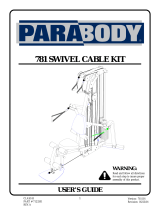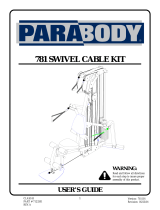
2
All Rights Reserved
Printed in the USA
2003 by The Toro Company
8111 Lyndale Avenue South
Bloomington, MN 55420-1196
The engine exhaust from this product contains
chemicals known to the State of California to cause
cancer, birth defects, or other reproductive harm.
Warning
Important This engine is not equipped with a spark
arrester muffler. It is a violation of California Public
Resource Code Section 4442 to use or operate this engine
on any forest–covered, brush–covered or grass–covered
land. Other states or federal areas may have similar laws.
This spark ignition system complies with Canadian
ICES-002.
Ce système d’allumage par étincelle de véhicule est
conforme à la norme NMB-002 du Canada.
The enclosed Engine Owner’s Manual is supplied for
information regarding The U.S. Environmental
Protection Agency (EPA) and the California Emission
Control Regulation of emission systems, maintenance
and warranty.
Keep this engine Owner’s Manual with your unit.
Should this engine Owner’s Manual become damaged
or illegible, replace immediately. Replacements may be
ordered through the engine manufacturer.
Contents
Page
Introduction 3. . . . . . . . . . . . . . . . . . . . . . . . . . . . . . . . .
Safety 3. . . . . . . . . . . . . . . . . . . . . . . . . . . . . . . . . . . . . .
Safe Operating Practices 3. . . . . . . . . . . . . . . . . . . .
Toro Mower Safety 4. . . . . . . . . . . . . . . . . . . . . . . .
Slope Chart 7. . . . . . . . . . . . . . . . . . . . . . . . . . . . . . .
Safety and Instruction Decals 9. . . . . . . . . . . . . . . . .
Gasoline and Oil 13. . . . . . . . . . . . . . . . . . . . . . . . . . . . .
Recommended Gasoline 13. . . . . . . . . . . . . . . . . . . . .
Using Stabilizer/Conditioner 13. . . . . . . . . . . . . . . . .
Filling the Fuel Tank 13. . . . . . . . . . . . . . . . . . . . . . .
Check Engine Oil Level 13. . . . . . . . . . . . . . . . . . . . .
Setup 14. . . . . . . . . . . . . . . . . . . . . . . . . . . . . . . . . . . . . .
Loose Parts 14. . . . . . . . . . . . . . . . . . . . . . . . . . . . . . .
Installing the Drive Wheels 14. . . . . . . . . . . . . . . . . .
Installing the Upper Handle 15. . . . . . . . . . . . . . . . . .
Installing the Control Rods 15. . . . . . . . . . . . . . . . . .
Activating the Battery 16. . . . . . . . . . . . . . . . . . . . . .
Page
Operation 17. . . . . . . . . . . . . . . . . . . . . . . . . . . . . . . . . . .
Think Safety First 17. . . . . . . . . . . . . . . . . . . . . . . . . .
Controls 17. . . . . . . . . . . . . . . . . . . . . . . . . . . . . . . . .
Starting and Stopping the Engine 18. . . . . . . . . . . . . .
Operating Mower Blade Control (PTO) 18. . . . . . . .
The Safety Interlock System 19. . . . . . . . . . . . . . . . .
Driving Forward or Backward 19. . . . . . . . . . . . . . . .
Placing Machine in Neutral 20. . . . . . . . . . . . . . . . . .
Stopping the Machine 20. . . . . . . . . . . . . . . . . . . . . .
Transporting Machines 20. . . . . . . . . . . . . . . . . . . . . .
Pushing the Machine by Hand 21. . . . . . . . . . . . . . . .
Side Discharge or Mulch Grass 21. . . . . . . . . . . . . . .
Adjusting the Height-of-Cut 21. . . . . . . . . . . . . . . . .
Adjusting Gage Wheels 22. . . . . . . . . . . . . . . . . . . . .
Adjusting Center Gage Wheels 22. . . . . . . . . . . . . . .
Tips for Mowing Grass 23. . . . . . . . . . . . . . . . . . . . .
Maintenance 24. . . . . . . . . . . . . . . . . . . . . . . . . . . . . . . . .
Recommended Maintenance Schedule 24. . . . . . . . .
Servicing the Air Cleaner 25. . . . . . . . . . . . . . . . . . . .
Servicing the Engine Oil 26. . . . . . . . . . . . . . . . . . . .
Servicing the Spark Plug 27. . . . . . . . . . . . . . . . . . . .
Greasing the Bearings and Bushings 28. . . . . . . . . . .
Cleaning the Cooling Systems 28. . . . . . . . . . . . . . . .
Checking the Tire Pressure 29. . . . . . . . . . . . . . . . . .
Servicing the Fuse 29. . . . . . . . . . . . . . . . . . . . . . . . .
Servicing the Fuel Tank 29. . . . . . . . . . . . . . . . . . . . .
Servicing the Fuel Filter 30. . . . . . . . . . . . . . . . . . . . .
Servicing the Hydraulic System 30. . . . . . . . . . . . . . .
Adjusting the By-pass Valve 31. . . . . . . . . . . . . . . . .
Servicing the Cutting Blades 32. . . . . . . . . . . . . . . . .
Correcting the Mower Quality of Cut 34. . . . . . . . . .
Checking the Deck Side-to-Side Leveling 35. . . . . . .
Replacing the Traction Belt 35. . . . . . . . . . . . . . . . . .
Replacing the Mower Belt 36. . . . . . . . . . . . . . . . . . .
Replacing the Drive Belt 36. . . . . . . . . . . . . . . . . . . .
Adjusting the Electric Clutch 37. . . . . . . . . . . . . . . . .
Adjusting the Machine Neutral 37. . . . . . . . . . . . . . .
Servicing the Battery 38. . . . . . . . . . . . . . . . . . . . . . .
Replacing the Caster Wheel Fork Bushings 39. . . . . .
Caster Wheel and Bearings Service 40. . . . . . . . . . . .
Replacing the Grass Deflector 41. . . . . . . . . . . . . . . .
Wiring Diagram 42. . . . . . . . . . . . . . . . . . . . . . . . . . .
Hydraulic Diagram 43. . . . . . . . . . . . . . . . . . . . . . . . .
Cleaning and Storage 43. . . . . . . . . . . . . . . . . . . . . . .
Troubleshooting 44. . . . . . . . . . . . . . . . . . . . . . . . . . . . . .






















